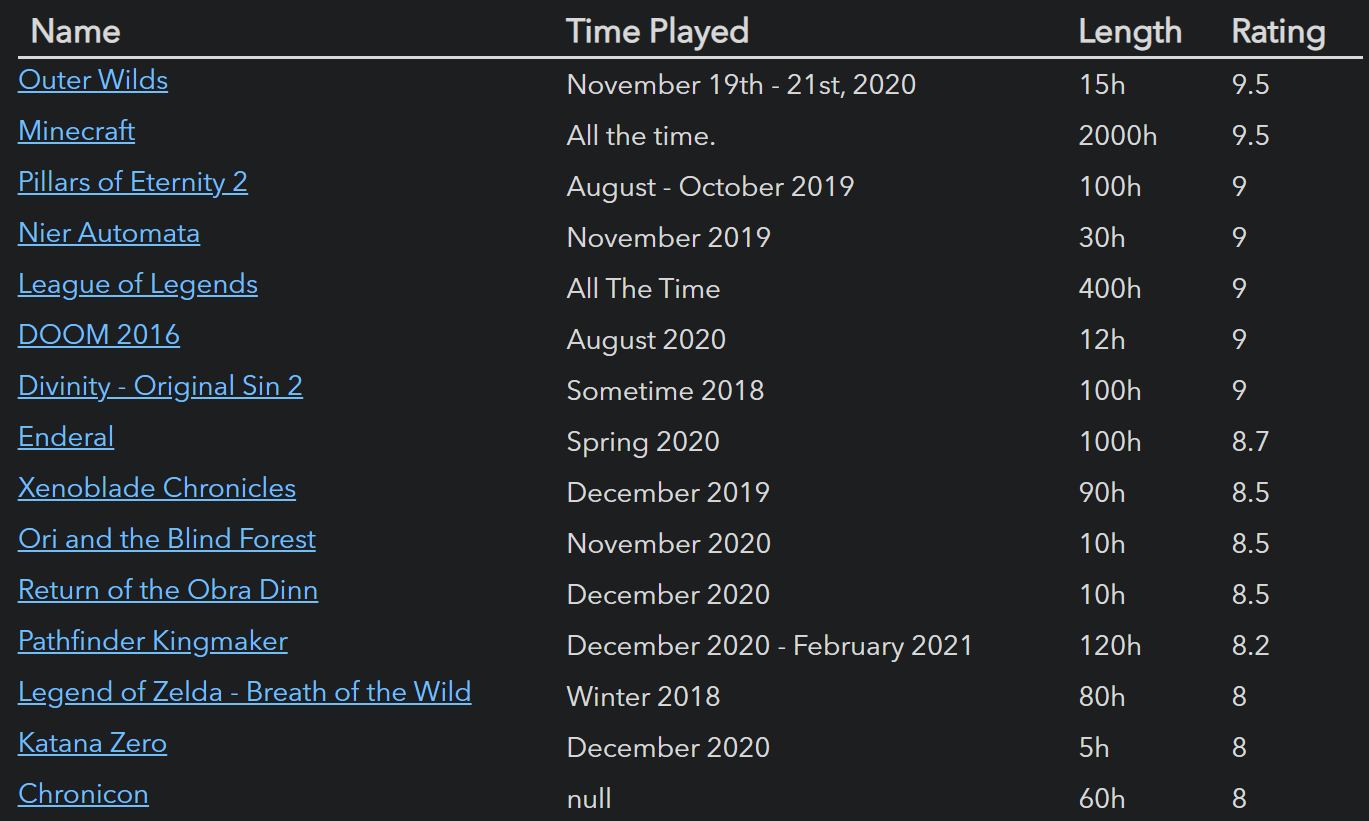Treat your Obsidian Vault as a database which you can query from. Provides a JavaScript API and pipeline-based query language for filtering, sorting, and extracting data from Markdown pages. See the Examples section below for some quick examples, or the full reference for all the details.
Show all games in the game folder, sorted by rating, with some metadata:
```dataview
table time-played, length, rating
from "games"
sort rating desc
```List games which are MOBAs or CRPGs.
```dataview
list from #game/moba or #game/crpg
```List all markdown tasks in un-completed projects:
```dataview
task from #projects/active
```Show all files in the books folder that you read in 2021, grouped by genre and sorted by rating:
```dataviewjs
for (let group of dv.pages("#book").where(p => p["time-read"].year == 2021).groupBy(p => p.genre)) {
dv.header(3, group.key);
dv.table(["Name", "Time Read", "Rating"],
group.rows
.sort(k => k.rating, 'desc')
.map(k => [k.file.link, k["time-read"], k.rating]))
}
```For a full description of all features, instructions, and examples, see the reference. For a more brief outline, let us examine the two major aspects of Dataview: data and querying.
Dataview generates data from your vault by pulling information from Markdown frontmatter and Inline fields.
- Markdown frontmatter is arbitrary YAML enclosed by
---at the top of a markdown document which can store metadata about that document. - Inline fields are a Dataview feature which allow you to write metadata directly inline in your markdown document via
Key:: Valuesyntax.
Examples of both are shown below:
---
alias: "document"
last-reviewed: 2021-08-17
thoughts:
rating: 8
reviewable: false
---# Markdown Page
Basic Field:: Value
**Bold Field**:: Nice!
You can also write [field:: inline fields]; multiple [field2:: on the same line].
If you want to hide the (field3:: key), you can do that too.Once you've annotated documents and the like with metadata, you can then query it using any of Dataview's four query modes:
-
Dataview Query Language (DQL): A pipeline-based, vaguely SQL-looking expression language which can support basic use cases. See the documentation for details.
```dataview TABLE file.name AS "File", rating AS "Rating" FROM #book ```
-
Inline Expressions: DQL expressions which you can embed directly inside markdown and which will be evaluated in preview mode. See the documentation for allowable queries.
We are on page `= this.file.name`.
-
DataviewJS: A high-powered JavaScript API which gives full access to the Dataview index and some convienent rendering utilities. Highly recommended if you know JavaScript, since this is far more powerful than the query language. Check the documentation for more details.
```dataviewjs dv.taskList(dv.pages().file.tasks.where(t => !t.completed)); ```
-
Inline JS Expressions: The JavaScript equivalent to inline expressions, which allow you to execute arbitary JS inline:
This page was last modified at `$= dv.current().file.mtime`.
JavaScript queries are very powerful, but they run at the same level of access as any other Obsidian plugin. This means they can potentially rewrite, create, or delete files, as well as make network calls. You should generally write JavaScript queries yourself or use scripts that you understand or that come from reputable sources. Regular Dataview queries are sandboxed and cannot make negative changes to your vault (in exchange for being much more limited).
Contributions via bug reports, bug fixes, documentation, and general improvements are always welcome. For more major feature work, make an issue about the feature idea / reach out to me so we can judge feasibility and how best to implement it.
The codebase is written in TypeScript and uses rollup / node for compilation; for a first time set up, all you
should need to do is pull, install, and build:
foo@bar:~$ git clone git@github.com:blacksmithgu/obsidian-dataview.git
foo@bar:~$ cd obsidian-dataview
foo@bar:~/obsidian-dataview$ npm install
foo@bar:~/obsidian-dataview$ npm run devThis will install libraries, build dataview, and deploy it to test-vault, which you can then open in Obsidian. This
will also put rollup in watch mode, so any changes to the code will be re-compiled and the test vault will automatically
reload itself.
If you want to dogfood dataview in your real vault, you can build and install manually. Dataview is predominantly a read-only store, so this should be safe, but watch out if you are adjusting functionality that performs file edits!
foo@bar:~/obsidian-dataview$ npm run build
foo@bar:~/obsidian-dataview$ ./scripts/install-built path/to/your/vaultWe use MkDocs for documentation (found in docs/). You'll need to have python and pip to run it locally:
foo@bar:~/obsidian-dataview$ pip3 install mkdocs mkdocs-material mkdocs-redirects
foo@bar:~/obsidian-dataview$ cd docs
foo@bar:~/obsidian-dataview/docs$ mkdocs serveThis will start a local web server rendering the documentation in docs/docs, which will live-reload on change.
Documentation changes are automatically pushed to blacksmithgu.github.io/obsidian-dataview once they are merged
to the main branch.
Dataview publishes TypeScript typings for all of its APIs onto NPM (as blacksmithgu/obsidian-dataview). For
instructions on how to set up development using Dataview, see setup instructions.
Have you found the Dataview plugin helpful, and want to support it? I accept donations which go towards future development efforts. I generally do not accept payment for bug bounties/feature requests, as financial incentives add stress/expectations which I want to avoid for a hobby project!




